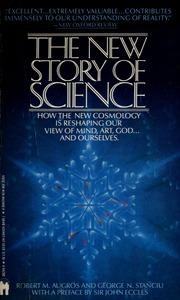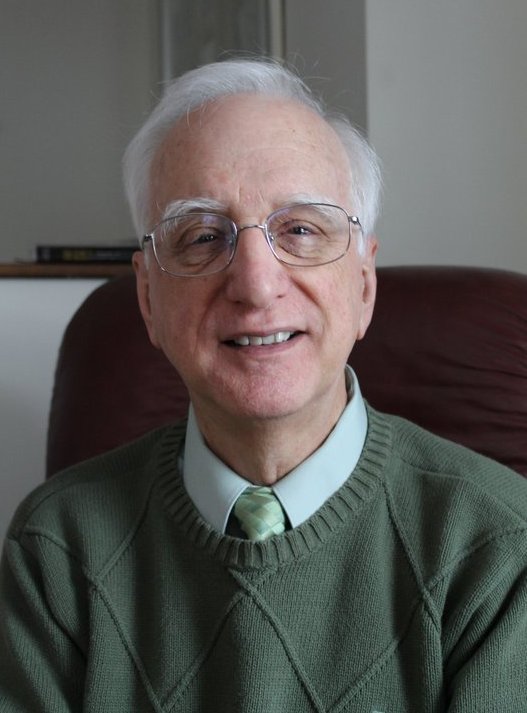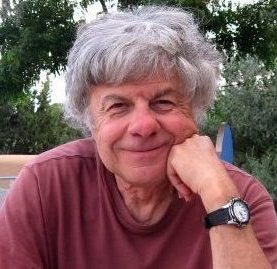|
home | what's new | other sites | contact | about |
|||||||
|
Word Gems exploring self-realization, sacred personhood, and full humanity
Augros & Stanciu's George Stanciu, PhD, theoretical physics
return to "Evolution" main-page
Editor's note: The following discussion summarizes Augros & Stanciu's The New Story Of Science, chapter three, "Beauty."
Occam’s Razor ornately gilded Occam’s Razor is a principle of well-constructed economy and parsimony. Any new theory, to be credible, should exhibit a beauty of simplicity, in that, assumptions should be kept to a barest elegant minimum. The theory with the fewest assumptions, the simplest in construction, is most likely to be correct. It needs to offer elegance, symmetry, clarity, brilliance, and harmony. Nothing can be added that doesn’t need to be there. And we use “Occam’s Razor” (William of Ockham, circa 1300 AD) to shave away all unnecessary detail. Why should simplicity and beauty rule our judgments? Because, as per the opinions of some of history’s greatest scientists – Newton, Einstein, Heisenberg, Schrodinger, Born, Wheeler, Penrose, Dirac, Watson, Bohm, and others – Nature is revealed as simplicity itself, beautiful in essence, once we truly see how things work. Materialistic science would have us believe that what we perceive as “beauty” is but mere trick of the mind. However, those credited with great scientific achievement scoff at this reductionism. I invite you to review the following quotations, with my comments at the end. Louis de Broglie: “In every epoch in the history of science, aesthetic feeling has been a guide that has directed scientists in their research.” James Watson, The Double Helix: “So we had lunch, telling each other that a structure this pretty just had to exist.” And “almost everyone … accepted the fact that the structure was too pretty not to be there.” Richard Feynman: "You can recognize truth by its beauty and simplicity. When you get it right, it is obvious that it is right." Werner Heisenberg: Beauty “in exact science, no less than in the arts … is the most important source of illumination and clarity.” Werner Heisenberg: Concerning quantum theory, it was “immediately found convincing by virtue of its completeness and abstract beauty.” Erwin Schrodinger: “Einstein’s marvelous theory of gravitation … could only be discovered by a genius with a strong feeling for the simplicity and beauty of ideas.” Albert Einstein: “Scarcely anyone who fully understands this [gravitational] theory can escape its magic.” Paul Dirac: “It is more important to have beauty in one's equations that to have them fit experiment. If Schrodinger had been more confident of his work, he could have published it some months earlier, and he could have published a more accurate equation. It seems that if one is working from the point of view of getting beauty in one's equations, and if one has really a sound insight, one is on a sure line of progress. If there is not complete agreement between the results of one's work and experiment, one should not allow oneself to be too discouraged, because the discrepancy may well be due to minor features that are not properly taken into account and that will get cleared up with further development of the theory." Sir George Thompson: “One can always make a theory, many theories, to account for known facts, occasionally even to predict new ones. The test is aesthetic. Some theories are cumbrous, limited in scope and arbitrary. They seldom live long.” Feynman and Gell-Mann: Beauty even challenges what appear to be facts. In 1958 these two researchers, proposing a new theory of weak interaction, did so even though it contradicted the findings of a number of experiments. It’s main attraction was its beauty: “It’s universal, it’s symmetric … it is the simplest possibility,” and this “indicates that these [previously conducted] experiments are wrong.” Gell-Mann further comments: “Frequently a theorist will throw out a lot of data on the grounds that if they don’t fit an elegant scheme, they’re wrong. That’s happened to me many times. The theory of weak interactions: there were nine experiments that contradicted it – all wrong. Every one. When you have something simple that agrees with all the rest of what’s going on, a few experimental data against it are no objection whatever. Almost certain to be wrong.” Hermann Weyl: If occasionally a supremely elegant theory does not fit one group of facts, it inevitably finds application elsewhere. In the 1920s Hermann Weyl’s aesthetically perfect gauge theory did not fit gravitational theory. However, much later it was found to illuminate quantum electrodynamics, which confirmed the value of the earlier aesthetic judgment. Hermann Weyl: "My work always tried to unite the true with the beautiful, but when I had to choose one or the other, I usually chose the beautiful." Eric Temple Bell: "Guided only by their feeling for symmetry, simplicity, and generality, and an indefinable sense of the fitness of things, creative mathematicians now, as in the past, are inspired by the art of mathematics rather than by any prospect of ultimate usefulness." Godfrey H. Hardy: "The mathematician's patterns, like the painter's or the poet's, must be beautiful; the ideas, like the colors or the words must fit together in a harmonious way. Beauty is the first test: there is no permanent place in this world for ugly mathematics." J.J. Sylvester Presidential Address to British Association, 1869: "The world of ideas which [mathematics] discloses or illuminates, the contemplation of divine beauty and order which it induces, the harmonious connexion of its parts, the infinite hierarchy and absolute evidence of the truths with which it is concerned, these, and such like, are the surest grounds of the title of mathematics to human regard, and would remain unimpeached and unimpaired were the plan of the universe unrolled like a map at our feet, and the mind of man qualified to take in the whole scheme of creation at a glance." H. E. Huntley: "If a poet sees beauty in a rainbow ... so does the physicist in the laws governing its manifestation. The surface beauty of the rainbow ... is appreciated by all men: it is given. But the buried beauty, uncovered by the industrious researches of the physicist, is understood only by the scientifically literate. It is acquired: education is essential." J. B. Shaw: "The mathematician is fascinated with the marvelous beauty of the forms he constructs, and in their beauty he finds everlasting truth." Edward C. Randall: "There is nothing in the great scheme of nature that, when understood, is not simple, harmonious, and beautiful." Buckminster Fuller: "When I am working on a problem, I never think about beauty. I only think of how to solve the problem. But, when I have finished, if the solution is not beautiful, I know it is wrong." Albert Einstein: "The ideals which have lighted my way, and time after time have given me new courage to face life cheerfully, have been Kindness, Beauty, and Truth." J. W. A. Young: "Mathematics has beauties of its own -- a symmetry and proportion in its results, a lack of superfluity, an exact adaptation of means to ends, which is exceedingly remarkable and to be found only in the works of the greatest beauty. When this subject is properly ... presented, the mental emotion should be that of enjoyment of beauty..." Albert Einstein: He summarizes three specific elements of beauty: “A theory is the more impressive the greater the simplicity of its premises is, the more different kinds of things it relates, and the more extended is its area of applicability.” Roger Penrose: “Most rival theories [to Einstein’s] are convincingly disproved, the few that remain having been, for the most part, contrived directly so as to fit with those tests that have been actually performed. No rival theory comes close to general relativity in elegance or simplicity of assumption.” Henri Poincare: The principle of simplicity implies two things: completeness and economy. “It is because simplicity and vastness are both beautiful that we seek by preference simple facts and vast facts.” A theory, beautiful by this standard, must take into account all the facts and must include only what is necessary. Nothing lacking, nothing superfluous. Albert Einstein: He declares that “without the belief in the inner harmony of the world there could be no science.” Werner Heisenberg: He describes harmony as the “proper conformity of the parts to one another and to the whole.” A good theory will harmonize many previously unrelated facts. John Wheeler: Harmony also implies symmetry. There is a pleasing symmetry to the laws of physics. “Every law of physics … goes back to some symmetry of nature.” John Wheeler: "It is my opinion that everything must be based on a simple idea. And ... that this idea, once we have finally discovered it, will be so compelling, so beautiful, that we will have to say ... yes, how could it have been any different." John Wheeler: "Spinoza was Einstein's greatest [inspiration]. No one expressed more strongly ... a belief in harmony, the beauty ... of nature." Werner Heisenberg: “The symmetry properties always constitute the most essential features of a theory.” Isaac Newton: His third law is a well-known example of symmetry in physics: “To every action there is always opposed an equal reaction.” This mirror symmetry is found on the subatomic level, where to every kind of particle there corresponds an anti-particle with the same mass but with opposite characteristics. In fact, the successful prediction of the existence of many subatomic particles was made primarily on the basis of this symmetry. Also, in this vein, the Periodic Table of Elements reveals an astounding symmetry in with each successive atom on the chart harboring one additional proton. Isaac Newton: A theory with the quality of “brilliance” has great clarity in itself and sheds light on many other things. Newton astounded the world by explaining falling bodies, the tides, and the motions of the planets and the comets with three simple laws. Richard Feynman: “The truth always turns out to be simpler than you thought.” George Thomson: “In physics, as in mathematics, it is a great beauty if a theory can bring together apparently very different phenomena and show that they are closely connected; or even different aspects of the same thing.” S. Chandrasekhar: General relativity “consists primarily in relating, in juxtaposition, two fundamental concepts which had, till then, been considered as entirely independent: the concepts of space and time, on the one hand, and the concept of matter and motion on the other.” Moreover, general relativity has proven extraordinarily brilliant, shedding its light on cosmology, astrophysics, and quantum mechanics. Isaac Newton: “Nature is pleased with simplicity, and affects not the pomp of superfluous causes.” Richard Feynman: “Nature has simplicity and therefore great beauty.” Max Born: “The genuine physicist believes obstinately in the simplicity and unity of nature, despite any appearance to the contrary.” Werner Heisenberg, discussing with Einstein: “I believe, just like you, that the simplicity of natural laws has an objective character, that it is not just the result of thought economy. If nature leads us to mathematical forms of great simplicity and beauty … we cannot help thinking they are true, that they reveal a genuine feature of nature.” S. Chandrasekhar: “All of us are sensitive to nature’s beauty. It is not unreasonable that some aspects of this beauty are shared by the natural sciences.” David Bohm: “Almost anything to be found in nature exhibits some kind of beauty both in the immediate perception and in intellectual analysis.” Henri Poincare: “The scientist does not study nature because it is useful to so. He studies it because he takes pleasure in it; and he takes pleasure in it because it is beautiful. If nature were not beautiful, it would not be worth knowing and life would not be worth living.” Hyatt Carter: "Nobel Prize winner Richard Feynman felt an enchantment that would last for a lifetime when he heard his high-school physics teacher say: Light always follows the path of the beautiful." C.P. Snow: Beauty provides common ground between science and the fine arts: “Anyone who has every worked in any science knows how much aesthetic joy he obtained. That is, in the actual activity of science, in the process of making a discovery, however humble it is, one can’t help feeling an awareness of beauty. The subjective experience, the aesthetic satisfaction, seems exactly the same as the satisfaction one gets from writing a poem or a novel, or composing a piece of music.” Steven Weinberg: “Science has certain parallels with art… there is the quest by scientists for beauty and simplicity. We pursue this because we believe that the fundamental laws underlying nature have to be simple; so we look for simplicities that might mirror the ultimate simplicities of the laws of nature. In my field, elementary particle physics, we have discovered that nature is far more simple than it appears superficially. The simplicity takes the form of principles of symmetry. For example, there’s a deep symmetry between two elementary particles – the neutrino and the electron – that superficially appear to have quite different properties.” Steven Weinberg: A further parallel in the way scientists and artists work: “Scientists, like artists, rely heavily on intuition. Very often I turn my back on a whole line of work because it just doesn’t feel right to me, or I’ll spend months developing a line of work because it has just the right feeling.” Werner Heisenberg: “It is probably correct to say that the world of poetry has been familiar to all really great scientists. The physicist, at any rate, also needs to discover the harmonies of natural events.” Notice Heisenberg’s superlative: “all really great scientists” are led by the aesthetic principle. Is his statement a little too self-congratulatory? Well, we might have to give him a pass here as he’s credited with discovering “the most profound concept in all of science.” So maybe he might know. (Read about his discovery on the “Theory Of Everything” page. What does all this mean? You'll want to read the first three articles on "Beauty," however - the answer here ranks with the most important information we might attain to in life. It’s not easy to talk about this as there’re so much dysinformation, so many competing voices, in the marketplace. Listen to them, hear what they say: “Here’s how to find truth! Just join our religious group or political party or subscribe to this-or-that materialistic view, and you’ll be part of the chosen few.” (See more discussion on the “Cultism” page.) Science, unless it’s politically driven, is a quest for the truth. And truth is nothing more than reality. It’s what’s real. It’s how things really are. Nature is what it is. Further, all truth, all reality, is of a piece. Everything’s connected. Every subject is connected to all other subjects. Editor’s note: This concept is embedded in the term “encyclopedia,” which means “circle of knowledge.” This means that there's no separate reality for science, and another one for religion, and another reality for something else. Everything, as we said, is connected. And this is why the great scientists, in their research, have learned to respect clues which lead them to perceptions of reality’s harmony, symmetry, and simplicity. When they find this, they call it “beauty.” The quoted scientists talk like artists; and they call themselves artists. They say things like, “I had a strong hunch that the theory was correct because it just had the right feel to it.” This is how writers and musicians talk – but we might not have realized that this same sense of creative intuition also guides the great scientists. Another comment that I really liked: “Our new theory is beautiful in its simplicity, and we just know it’s correct; however, it contradicts the findings – what we believed were facts – of many other experiments. Even so, what we thought were done-and-settled experimental findings must be wrong. Why? Because our new theory is beautiful and, on that basis, we know it’s correct.” Is this not an astounding method by which scientific truth is substantiated? We expect this kind of “good feeling” talk from artists, but not from people in white lab coats. And yet, the world’s greatest scientists tell us this is the way it is.
Beauty becomes a Goodness-and-Truth detector In the article “Beauty, Part III” you will find discussion on how Beauty is the child of Goodness and Truth. The scientists affirm this. They’re telling us that when they find something that’s beautiful, then they know they’re onto something real and something good. At the beginning of this writing, I said I would comment on how Beauty relates to many other topics on the Word Gems site, and I’d like to do that now. Brevity must rule, of course, as so much could be said; as such, the following statements will be general in nature, without attempt to substantiate. That’s already been done for each of the topics, on its own page, where you’ll find extensive discussion, sometimes 40 or 50 sub-articles of related information. It’s there for you when you want it. Each of the following represents a major focus on Word Gems. Allow me to briefly comment concerning how Beauty relates to these subjects. God and Jesus Christ: The religious organizations of this world offer their tortured theories concerning the nature and meaning of these icons. In most cases, we will be forced to reject out-of-hand their theories – because they’re not beautiful. God is presented to us as a rigid bureaucrat, a humorless potentate, even a monster, who is held hostage to his own law. He cannot simply be kind, forgive and forget. Instead, like a sociopath, he demands blood, heads mounted on poles, and licenses sexual depravity. He engages in all manner of immorality and impropriety, as presented in the Old Testament, of the sort which he commands us, in split-personality, to eschew. This is not the real God of the cosmos but a small local chieftain crafted in the image of Ashurbanipal. Reincarnation: If “R” were true, it would be the greatest personal calamity for each of us. We would have nothing to live for, no hope of future reunion. All of our loved ones would be lost to us, forever, in the swirling existential goup of hundreds or thousands of incarnational “make-overs,” with untold numbers of new husbands, new wives, new genders, new parents, new personalities, etc., etc. “R” represents the most grotesque and loveless, the most feckless and hideous proposition ever presented to humankind. Mercifully, for a great many reasons, none of this bankrupt theory, under close inspection, will be found to hold any water; however, a prime reason why it's not true - it’s not beautiful. Hardly. Bible, and other “infallible” books (including "infallible" gurus): We are not to “check our brains at the door” in favor of some purported perfect book with all the answers. Life is not a spectator sport. Our own judgment, even if presently wrong, will yet teach us, be corrected and refined, on our way toward spiritual maturity. That's how we learn. Further, to suggest that the complexities of life, in its myriad of nuances, could be addressed and negotiated, bottled and formulated, by consulting a patched-together book written by dozens of authors over hundreds of years, is a pathetic premise, and has no hope of conforming to reality. None of this is beautiful, and to support any of this intellectual barbarity is the essence of cultism. There are no final answers in this world, no infallible sources of knowledge, no escaping a systemic lack of certitude. John Wheeler had it spot-on right: "We live on an island of knowledge surrounded by an ocean of ignorance. As our island of knowledge grows, so does the shore of our ignorance." And since this article finds its home-base on the “Evolution” page, we must say a few words in that regard, as well: Evolution: Both strands of modern biological evolutionary theory – Creationism and Darwinism – fall short of the mark of addressing all of the data; with the latter, in my opinion, as the greater offender. Are we human beings nothing more than an aggregate of “selfish genes” seeking for survival advantage? If so, why pursue the fine arts, which, etymologically, as Oscar Wilde quipped, are “quite useless.” They’re designed to be “useless,” offering no utilitarian benefit. Where’s the survival advantage in the “useless arts”? And why should we enter into love relationships? For mutual survival advantage, the materialist will assert. But we also love people we’ve lost, people who are dead and gone, and for whom we grieve, so much so at times that our own lives might sorrow unto early demise. Where’s the “selfish gene” advantage in that? And then the hard-core materialists will blather about “man has no free will,” that there is no true human consciousness: “It’s all cultural conditioning," they say, "just riding the wave of societal expectation and programming.” What saints, mystics, and philosophers revere as the highest virtues – love, joy, peace, heroic altruism, selfless deeds unto death – the materialists will posit, mean nothing and are simply secondary, emergent qualities of the brain. However, if this were really the case, if there's no such thing as purposeful creative thought, if there is no hegemonic human consciousness, then why should we believe anything the materialists have to say? – as their own party-platform, too, would merely be an orchestration by insentient subatomic particles; they, too, would just be puppets-on-a-string led by "the selfish gene." All of this Darwinistic sophism insults our intelligence. Darwinism, upon close inspection, shatters and falls apart. It cannot bear up under tight scrutiny, and is revealed as the shallow-reasoned theory that it is. There’s no harmony in it, no symmetry, no brilliance, it doesn’t feel right and can't pass the "smell test." Darwinism is the proverbial sterile mule, assembled by a committee, but meant to be a horse. We need to look elsewhere regarding the origins of humankind. Concerning the other Word Gems topics, I will ask you to offer your own commentary. I think you see how this works.
What's really going on with this notion of Beauty as indicator of Truth? I think it’s one of the proofs of God’s existence. The deeper we delve into almost any subject, concerning how the universe or life works, the more we’ll find an underlying framework, an architectonic substrata, of unity and harmony, a symmetry and simplicity, of pattern, composition, and order. From the glistening snowflake to the spiral galaxy, it's all beautiful.
This could not happen by accident. Only by design. And, if by design, then a Great Mind stands behind it all. Albert Einstein: “That deep emotional conviction of the presence of a superior reasoning power, which is revealed in the incomprehensible universe, forms my idea of God.”
|
|||||||
|
|




